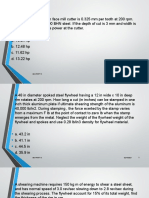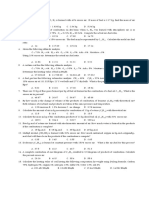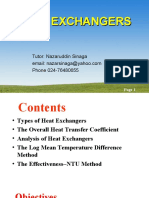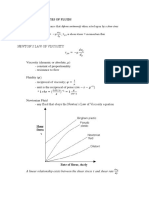50%(2)50% found this document useful (2 votes)
3K viewsSample Problems 3 ME21
Sample Problems 3 ME21
Uploaded by
Idate PatrickThe document contains multiple sample problems related to heat transfer and refrigeration. The problems involve calculating heat transfer through walls, heat exchangers, and insulated pipes using given material properties and temperature conditions. They also include questions about determining refrigeration capacity based on cooling load, temperature conditions, and thermodynamic cycle specifications.
Copyright:
© All Rights Reserved
Available Formats
Download as PDF, TXT or read online from Scribd
Sample Problems 3 ME21
Sample Problems 3 ME21
Uploaded by
Idate Patrick50%(2)50% found this document useful (2 votes)
3K views13 pagesThe document contains multiple sample problems related to heat transfer and refrigeration. The problems involve calculating heat transfer through walls, heat exchangers, and insulated pipes using given material properties and temperature conditions. They also include questions about determining refrigeration capacity based on cooling load, temperature conditions, and thermodynamic cycle specifications.
Copyright
© © All Rights Reserved
Available Formats
PDF, TXT or read online from Scribd
Share this document
Did you find this document useful?
Is this content inappropriate?
The document contains multiple sample problems related to heat transfer and refrigeration. The problems involve calculating heat transfer through walls, heat exchangers, and insulated pipes using given material properties and temperature conditions. They also include questions about determining refrigeration capacity based on cooling load, temperature conditions, and thermodynamic cycle specifications.
Copyright:
© All Rights Reserved
Available Formats
Download as PDF, TXT or read online from Scribd
Download as pdf or txt
50%(2)50% found this document useful (2 votes)
3K views13 pagesSample Problems 3 ME21
Sample Problems 3 ME21
Uploaded by
Idate PatrickThe document contains multiple sample problems related to heat transfer and refrigeration. The problems involve calculating heat transfer through walls, heat exchangers, and insulated pipes using given material properties and temperature conditions. They also include questions about determining refrigeration capacity based on cooling load, temperature conditions, and thermodynamic cycle specifications.
Copyright:
© All Rights Reserved
Available Formats
Download as PDF, TXT or read online from Scribd
Download as pdf or txt
You are on page 1of 13
At a glance
Powered by AI
The document presents various heat transfer and refrigeration problems involving calculation of heat transfer rates, temperatures, and refrigeration capacities. Key concepts include heat transfer through walls, heat exchangers, and refrigeration cycles.
Examples of heat transfer problems presented include calculating heat transfer through a brick wall, furnace wall, and determining heat loss per unit area. Other examples involve composite walls, heat exchangers, and insulated pipes.
When calculating heat transfer through composite walls, the key components involved are the thermal conductivity of each material, thickness of each layer, internal and external surface heat transfer coefficients, and internal and external temperatures.
Sample Problems
Calculate the heat transfer in kJ per hour through a solid
brick wall 6 m long, 2.9 m high, and 225 mm thick, when
the outer surface is at 5C and the inner surface is 17C, the
coefficient of thermal conductivity of the brick is 0.6 W/m-K.
A vertical furnace wall is made up of an inner wall of
firebrick 20 cm thick followed by insulating brick 15 cm
thick and an outer wall of steel 1 cm thick. The surface
temperature of the wall adjacent to the combustion
chamber is 1200C while that of the surface of steel is 50C.
The thermal conductivities of the wall is 0.26 W/m-K;
insulating brick at 10 W/m-K; and steel at 45 W/m-K.
Neglecting the film resistances and contact resistance of
joints, determine the heat loss per square meter of wall
area.
A composite wall is made up of an external
thickness of brickwork 110 mm thick inside which is
a layer of fibreglass 75 mm thick. The fiberglass is
faced internally by an insulating board 25 mm
thick. The coefficient of thermal conductivity for the
three are as follows: Brickwork-1.5W/m-K;
Fiberglass-0.04 W/m-K; Insulating board-0.06 W-mK. The surface transfer coefficients of the inside
wall is 3.1W/m2-K while that of the outside is 2.5 W/
m2-K. Take the internal ambient temperature as
10C and the external temperature is 27C.
Determine the heat loss through such wall 6 m high
and 10 m long.
A heat exchanger is to be designed for the
following specifications: Hot gas temperature =
1145C; Cold gas temperature = 45C; Convective
film coefficient on the hot side = 230 W/m2-K;
Convective film coefficient on the cold side = 290
W/m2-K; thermal conductivity of the metal wall =
115 W/m-K. Find the maximum thickness of the
metal wall between the hot gas and the cold gas so
that the maximum temperature of the wall does not
exceed 545C.
A 3mm diameter and 5m long electric wire is tightly
wrapped with a 2mm thick plastic cover whose
thermal conductivity is 0.15 W/m-K. Electrical
measurement indicate that a current of 10A passes
through a wire and there is a voltage drop of 8V
along the wire. If the insulated wire is exposed to a
medium at 30C, with heat transfer coefficient h=12
W/m2-K, determine the interface temperature of the
wire.
An insulated steam pipe located where the ambient
temperature is 32C, has an inside diameter of
50mm with 10mm thick wall. The outside diameter
of the corrugated asbestos insulation is 125mm
and the surface coefficient of still air, ho = 12 W/
m2-K. Inside the pipe is steam having a
temperature of 150C with film coefficient hi = 6000
W/m2-K. Thermal conductivity of pipe and
asbestos insulation are 45 and 0.12 W/m-K,
respectively. Determine the heat loss per unit
length of pipe.
How many watts will be radiated from a spherical
black body 15 min diameter at a temperature of
800C?
At an average temperature of 100C, hot air flows
through a 2.5 m long tube with an inside diameter
of 50 mm. The temperature of the tube is 20C along
its entire length. Convective film coefficient os 20.1
W/m2-K. Determine the convective heat transfer
from air to the tube.
How many tons of refrigeration are required to
produce 10 metric tons of ice per day at -15C from
raw water at 25C if miscellaneous losses are 15%
of the chilling and freezing load?
A creamery must cool 20,000L of milk received
each day from initial temperature of 29C to a final
temperature of 2C in 5 hours. If refrigeration losses
amount to 10% of the chilling load, what must be
the capacity of the refrigerating machine in TOR?
Magnolia Dairy products plant must cool 4000
gallons of fresh milk received from the farm per day
from an initial temperature of 80F to a temperature
of 38F in 5 hours. If the density of milk is 8.6lb/gal
and specific heat is 0.935 BTU/lb-R, what must be
the capacity of the refrigerating machine in TOR?
Fish weighing 11,000 kg with a temperature of 20C
is brought to a cold storage and which shall be
cooled to -10C in 11 hours. Find the required plant
refrigerating capacity in TOR if the specific heat of
fish is 0.7 kCal/kg-K above freezing and 0.30 kCal/
kg-K below freezing point which is -3C. The latent
heat of freezing is 55.5 kCal/kg.
An ideal vapor compression cycle requires 5 kW to
power the compressor. You have found the
following data for the cycle: the enthalpy at the
condenser entrance = 203 kJ/kg,exit = 55kJ/kg;
evaporator exit = 178 kJ/kg. If the mass flow rate of
the refrigerant is 0.20 kg/s, then the coefficient of
performance of this refrigeration cycle is most
nearly:
A refrigeration system operates on an ideal vapour
compression using R-12 with an evaporator
temperature of -30C and a condenser exit
temperature of 49.30C and requires 74.6kW motor
to drive the compressor. What is the capacity of the
refrigerator in TOR? Enthalpy at condenser
entrance = 382 kJ/kg, exit = 248.15 kJ/kg, at
evaporator entrance = 248.15 kJ/kg, exit = 338.14
kJ/kg.
A refrigerator is 2 m high, 1.2 m wide and 1 m
deep. The overall heat transfer coefficient is 0.532
W/m^2-K. How many kilograms of 0C ice will melt
per hour if the inside temperature is maintained at
10C while the surrounding air temperature is 35C?
In a CO2 refrigerating plant, the specific enthalpy
of the refrigerant as it leaves the condenser is 135
kJ/kg and as it leaves the evaporator it is 320 kJ/
kg. If the mass flow of the refrigerant is 5 kg/min,
calculate the refrigerating capacity per hour.
You might also like
- Introduction+to+Indutrial+Plant+ +Stocks+and+ChimneyDocument21 pagesIntroduction+to+Indutrial+Plant+ +Stocks+and+Chimneym4rkyyy TordzNo ratings yet
- CORMS BiologyDocument13 pagesCORMS BiologyNishchay BhattNo ratings yet
- Cengel Thermodynamics Heat Transfer 2nd TXTBKDocument865 pagesCengel Thermodynamics Heat Transfer 2nd TXTBKicething91% (23)
- HND Sector 1 Vol1Document477 pagesHND Sector 1 Vol1Guinete Herve100% (1)
- Thermo 2 Problem SetDocument3 pagesThermo 2 Problem SetElisif DeFairNo ratings yet
- Module 6 Exercises Problem No. 3Document2 pagesModule 6 Exercises Problem No. 3Ariel GamboaNo ratings yet
- Problem Set 1Document2 pagesProblem Set 1vinard milanoNo ratings yet
- Chapter 03Document8 pagesChapter 03stephen jamesNo ratings yet
- Module 6 Exercises Problem No. 4Document3 pagesModule 6 Exercises Problem No. 4Ariel GamboaNo ratings yet
- Balingt - Prelim ExamDocument21 pagesBalingt - Prelim ExamRene Niño Macamay BalingitNo ratings yet
- Problems On Screws PDFDocument6 pagesProblems On Screws PDFJerome BalatbatNo ratings yet
- Chapter 04Document5 pagesChapter 04stephen jamesNo ratings yet
- Section 16Document97 pagesSection 16Carolina FerrerNo ratings yet
- Gas Turbine PowerplantDocument1 pageGas Turbine PowerplantVon A. DamirezNo ratings yet
- Feedwater Heater - Regeneration Analysis - HandbookDocument19 pagesFeedwater Heater - Regeneration Analysis - HandbookAnonymous wIPMQ5rhNo ratings yet
- Refrigeration Problem SetsDocument5 pagesRefrigeration Problem SetsNiño Gerard JabagatNo ratings yet
- Diesel Power Plant Problem Solving Examination NAME: Vincent Rey Olario Y. Bsme - 5 Show Complete Solutions. Solve The Following: Problem 1Document4 pagesDiesel Power Plant Problem Solving Examination NAME: Vincent Rey Olario Y. Bsme - 5 Show Complete Solutions. Solve The Following: Problem 1BensoyNo ratings yet
- Answer SheetDocument7 pagesAnswer SheetCharles Michael Bautista Hosmillo100% (1)
- Thermodynamics 2 - 2Document82 pagesThermodynamics 2 - 2Collin FarNo ratings yet
- Watertube Boilers HaveDocument175 pagesWatertube Boilers Havenathaniel villanuevaNo ratings yet
- Putrika Citta Pramesi 14/369486/TP/11122: 1 2 Container P, Container Freeze Latent P, Fresh P, FrozenDocument2 pagesPutrika Citta Pramesi 14/369486/TP/11122: 1 2 Container P, Container Freeze Latent P, Fresh P, Frozenputrikacitta3924No ratings yet
- M2 Activity4 PDFDocument1 pageM2 Activity4 PDFChristian EspirituNo ratings yet
- Section 16 PDFDocument97 pagesSection 16 PDFherrerafaridNo ratings yet
- Chapter 02Document14 pagesChapter 02stephen jamesNo ratings yet
- PPD Fuels and Combustion Lesson 1Document29 pagesPPD Fuels and Combustion Lesson 1neil palmaNo ratings yet
- Refrigeration Problem 1-2 SolvedDocument4 pagesRefrigeration Problem 1-2 SolvedNorma FrancoNo ratings yet
- Diesel Power Plant Problem Solving Examination NAME: Vincent Rey Olario Y. Bsme - 5 Show Complete Solutions. Solve The Following: Problem 1Document5 pagesDiesel Power Plant Problem Solving Examination NAME: Vincent Rey Olario Y. Bsme - 5 Show Complete Solutions. Solve The Following: Problem 1BensoyNo ratings yet
- Chapter 9Document4 pagesChapter 9Marco LuigiNo ratings yet
- Exercises Problem 1 Ref and Air Con MamaclayRADocument3 pagesExercises Problem 1 Ref and Air Con MamaclayRALeyzer MalumayNo ratings yet
- Chapter 9-Hydroelectric Plant PDFDocument118 pagesChapter 9-Hydroelectric Plant PDFsindyNo ratings yet
- PipeDocument168 pagesPipeSunde PascuaNo ratings yet
- (x3) Problem 1 - 4 Industrial CompressorDocument13 pages(x3) Problem 1 - 4 Industrial CompressorLester Alfred M. OlasimanNo ratings yet
- Astig M.E.Document21 pagesAstig M.E.Aj Buniag100% (1)
- Airconditioning: Various Methods of Handling The Air Supplied To A Condition SpaceDocument26 pagesAirconditioning: Various Methods of Handling The Air Supplied To A Condition SpaceDarklothar0% (1)
- MODULE 03 and 04 Problem SetDocument5 pagesMODULE 03 and 04 Problem SetIan Arnold FamiNo ratings yet
- Dryers and Drying: KG M Gain ReDocument5 pagesDryers and Drying: KG M Gain ReMarc BitangNo ratings yet
- Pipe LastDocument8 pagesPipe LastRENE JOSHUA PECASONo ratings yet
- Pineapple CutterDocument4 pagesPineapple CutterRIGOBERTO LOZANO MOLINANo ratings yet
- MD-1 BearingsDocument2 pagesMD-1 BearingsEleisa SilvaNo ratings yet
- Simple (Ideal) Vapor Compression Refrigeration Cycle ProblemsDocument3 pagesSimple (Ideal) Vapor Compression Refrigeration Cycle Problemssajawal hassanNo ratings yet
- Clutches, Brakes and FlywheelsDocument23 pagesClutches, Brakes and FlywheelsNauman KhanNo ratings yet
- ARAÑA MECC486 P2 M4AssignmentDocument15 pagesARAÑA MECC486 P2 M4AssignmentKent LabajoNo ratings yet
- Thermo 2Document14 pagesThermo 2Yato QtNo ratings yet
- Sample Exercises Rankine CycleDocument1 pageSample Exercises Rankine CycleLily Antonette AgustinNo ratings yet
- Deophantine 3 ProblemsDocument104 pagesDeophantine 3 ProblemsCaro Kan Lopez0% (1)
- Ompad Ipe 02 Prob.8Document3 pagesOmpad Ipe 02 Prob.8Sam Ompad100% (1)
- Can I Now Identify The Concepts of The Following:: Name:. Yr & Sec.: Date: RATINGDocument4 pagesCan I Now Identify The Concepts of The Following:: Name:. Yr & Sec.: Date: RATINGMurvin VillarosaNo ratings yet
- 19 21Document6 pages19 21Aub Enriquez100% (1)
- A. B. 0.99 M /KG 0.79 M /KG 0.89 M /KG 0.69m /KGDocument143 pagesA. B. 0.99 M /KG 0.79 M /KG 0.89 M /KG 0.69m /KGRyan Togonon100% (1)
- Pipe 4Document19 pagesPipe 4Mark AllenNo ratings yet
- Homework No.13: Aaron Enrique M. Magsino ME-5301Document5 pagesHomework No.13: Aaron Enrique M. Magsino ME-5301Adrian Kim MagsinoNo ratings yet
- IPE Plate 3Document29 pagesIPE Plate 3Lee Anthony ChingNo ratings yet
- Vacuum Pump-Lifting WaterDocument2 pagesVacuum Pump-Lifting WaterDesiree MolinaNo ratings yet
- Me Lab 3Document27 pagesMe Lab 3Jerome Vega AndesNo ratings yet
- Fundamentals of Deformable BodiesDocument14 pagesFundamentals of Deformable BodiesroylojunjunNo ratings yet
- Chapter 18Document4 pagesChapter 18Marco LuigiNo ratings yet
- PIPE 180 Updated 2015Document180 pagesPIPE 180 Updated 2015joe1256No ratings yet
- REFSYS - 3ME-8 (2ND SEM/ A.Y. 2020-2021) Midterm ExaminationDocument3 pagesREFSYS - 3ME-8 (2ND SEM/ A.Y. 2020-2021) Midterm ExaminationRobert GarlandNo ratings yet
- Preboards 1 MeslDocument4 pagesPreboards 1 MeslRonaldRajumNo ratings yet
- Problem Set PPE Day 1Document4 pagesProblem Set PPE Day 1Juan T AmadNo ratings yet
- Me152l - Experiment 6 - AmahmudDocument25 pagesMe152l - Experiment 6 - AmahmudAli Requiso MahmudNo ratings yet
- Heat Transfer and Refrigeration Problem SetDocument3 pagesHeat Transfer and Refrigeration Problem SetTricia IbabaoNo ratings yet
- Essentials of Modern Business Statistics (7e) : Anderson, Sweeney, Williams, Camm, CochranDocument57 pagesEssentials of Modern Business Statistics (7e) : Anderson, Sweeney, Williams, Camm, CochranIdate PatrickNo ratings yet
- Law1101 Chapter 2Document5 pagesLaw1101 Chapter 2Idate PatrickNo ratings yet
- Quiz 4 - GicaleDocument2 pagesQuiz 4 - GicaleIdate Patrick100% (2)
- From Sieve No. 4 Trial 1:: Sample ComputationDocument3 pagesFrom Sieve No. 4 Trial 1:: Sample ComputationIdate PatrickNo ratings yet
- A B C D: Toilet ToiletDocument1 pageA B C D: Toilet ToiletIdate PatrickNo ratings yet
- Law1101 Chapter 2Document14 pagesLaw1101 Chapter 2Idate PatrickNo ratings yet
- John Locke The Labor Theory of Value: Karen VaughnDocument16 pagesJohn Locke The Labor Theory of Value: Karen VaughnIdate PatrickNo ratings yet
- Courses To TakeDocument2 pagesCourses To TakeIdate PatrickNo ratings yet
- Vocal Elements: Voiced - The Vocal Folds Are Set in Voiceless - The Vocal Folds Do Not VibrateDocument3 pagesVocal Elements: Voiced - The Vocal Folds Are Set in Voiceless - The Vocal Folds Do Not VibrateIdate PatrickNo ratings yet
- CE140-1P Homework 1Document11 pagesCE140-1P Homework 1Idate PatrickNo ratings yet
- Symbol Systems: Nonverbal Symbols: Lesson 4Document24 pagesSymbol Systems: Nonverbal Symbols: Lesson 4Idate PatrickNo ratings yet
- CE140-1P - Lab Report Front PageDocument1 pageCE140-1P - Lab Report Front PageIdate PatrickNo ratings yet
- Ms. Ma. Cecilia OrtizDocument1 pageMs. Ma. Cecilia OrtizIdate PatrickNo ratings yet
- Mapúa Institute of Technology: School of Civil, Environmental and Geological EngineeringDocument1 pageMapúa Institute of Technology: School of Civil, Environmental and Geological EngineeringIdate PatrickNo ratings yet
- 1 Fluid-Properties Tutorial-Solution PDFDocument15 pages1 Fluid-Properties Tutorial-Solution PDFIdate PatrickNo ratings yet
- CE120 0F FieldWork#1Document5 pagesCE120 0F FieldWork#1Idate PatrickNo ratings yet
- Phy11l - E203Document3 pagesPhy11l - E203Idate PatrickNo ratings yet
- Our Proposed Business Will Be Named (3 Choices)Document7 pagesOur Proposed Business Will Be Named (3 Choices)Idate PatrickNo ratings yet
- Btob-Insane (Fanchant Color: Red)Document8 pagesBtob-Insane (Fanchant Color: Red)Idate PatrickNo ratings yet
- Phy11l - E201Document4 pagesPhy11l - E201Idate PatrickNo ratings yet
- Old Iit Bhu Mechanical SyllabusDocument32 pagesOld Iit Bhu Mechanical SyllabusRishi RajNo ratings yet
- Freestudy Heat Transfer Tutorial 1 - Conduction: (C) D.J.DunnDocument7 pagesFreestudy Heat Transfer Tutorial 1 - Conduction: (C) D.J.DunnAnonymous WBSQwYstfNo ratings yet
- PHD Thesis AbstractDocument2 pagesPHD Thesis AbstractDrEmadEl-SaidNo ratings yet
- Ass#4 - Fall 2017 (Q)Document3 pagesAss#4 - Fall 2017 (Q)Omar BahgatNo ratings yet
- 2.0 Basic Concepts On ThermodynamicsDocument17 pages2.0 Basic Concepts On ThermodynamicsLeo JohnNo ratings yet
- Equivalence of KelvinDocument6 pagesEquivalence of Kelvinashok pradhan100% (1)
- Dieño de Parametros Par Un Secador BatchDocument6 pagesDieño de Parametros Par Un Secador BatchCarlos CabanillasNo ratings yet
- GATE Solved Question Papers For Chemical Engineering by-AglaSem-Com PDFDocument59 pagesGATE Solved Question Papers For Chemical Engineering by-AglaSem-Com PDFChandra SekharNo ratings yet
- Double Pipe Heat ExchangerDocument88 pagesDouble Pipe Heat ExchangerirfanNo ratings yet
- Adiabatic and Semi-Adiabatic Calorimetry ToDocument14 pagesAdiabatic and Semi-Adiabatic Calorimetry TopedroNo ratings yet
- Thermodynamics of MaterialDocument120 pagesThermodynamics of MaterialDurga RajNo ratings yet
- PDF An Introduction to Physical Science 15th Edition James Shipman downloadDocument47 pagesPDF An Introduction to Physical Science 15th Edition James Shipman downloadzehensurdez100% (1)
- 6bab Iv (Cont'd)Document40 pages6bab Iv (Cont'd)Muhammad Randy AkbarNo ratings yet
- PDF Compre Special Project Ppe Ampipe DLDocument92 pagesPDF Compre Special Project Ppe Ampipe DLClint Baring ArranchadoNo ratings yet
- Heat Exchangers & Waste Heat RecoveryDocument30 pagesHeat Exchangers & Waste Heat RecoveryrsahayNo ratings yet
- Basics of Heat-Exchangers Design by N. SinagaDocument81 pagesBasics of Heat-Exchangers Design by N. SinagaİBRAHİM HAZAR AYTULUNNo ratings yet
- CRYOCARDocument19 pagesCRYOCARsheikh100% (1)
- Applied Thermal Engineering: SciencedirectDocument15 pagesApplied Thermal Engineering: SciencedirectmaxmanfrenNo ratings yet
- Design For Warm & Humid BookDocument163 pagesDesign For Warm & Humid BookLokesh SharmaNo ratings yet
- Ipc2012 90065Document10 pagesIpc2012 90065Marcelo Varejão CasarinNo ratings yet
- Classification of Heat ExchangersDocument12 pagesClassification of Heat Exchangersvishal samundreNo ratings yet
- Chapter 1. ThermodynamicsDocument51 pagesChapter 1. ThermodynamicsPhạm Việt DũngNo ratings yet
- Contoh-HE (Double pipe-LMTD-NTUDocument5 pagesContoh-HE (Double pipe-LMTD-NTUdirgantarajrNo ratings yet
- A Is Shear Stress Momentum FluxDocument21 pagesA Is Shear Stress Momentum FluxPamela MendozaNo ratings yet
- Differential Scanning Calorimetry: Heat CapacityDocument7 pagesDifferential Scanning Calorimetry: Heat Capacitymm11_nedNo ratings yet
- Intro1 M12 Thermal PDFDocument22 pagesIntro1 M12 Thermal PDFvovanpedenkoNo ratings yet
- Microfluidic Effects On The Heat Transfer Enhancement and Optimal Design of Microchannel Heat SinkDocument8 pagesMicrofluidic Effects On The Heat Transfer Enhancement and Optimal Design of Microchannel Heat SinkPappu S D NiluNo ratings yet













































































































